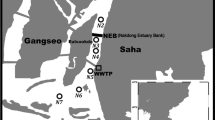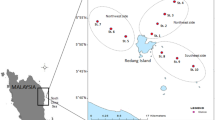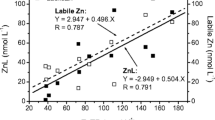Abstract
China’s natural waters are experiencing an increasingly anthropogenic perturbation widely including acidification and hypoxia, and toxic metals including copper (Cu) are subject to a series of reactions including chemical speciation and transformation. However, there is still little information available regarding such alterations of metal behaviors in China’s natural waters. By using solid phase extraction technique, this study for the first time measured total dissolved Cu, and different Cu species: toxic labile Cu (referred to those free cupric ions and some weakly organic compounds adsorbed onto Chelex-100 resins), the organic refractory Cu (referred to those adsorbed onto C18 resins after passing through Chelex-100 resins), and residual Cu (obtained by subtracting labile and organic refractory fractions from the total) in a freshwater lake (the Lover) and a saltwater lagoon (the Yundang) in Xiamen, China. Our results demonstrated that both waters were characterized with relatively low levels of total dissolved Cu (5–10 nM), as a result of a net removal process dominated by particle adsorption and precipitation. Relatively high proportion of organic refractory Cu (as high as 50 %) was observed in the saltwater Yundang lagoon as a result of organic matter production and/or discharges followed by complexation nearby. On the other hand, the toxic labile Cu accounted for >40 % of the total dissolved Cu pool in these waters, and particularly the increased proportion of toxic labile Cu (as high as 70 %) occurred in the bottom sulfidic Lover Lake. Our study provides clear evidence that toxic labile Cu could be transformed under reducing environments such as deep sulfidic waters of the Lover Lake (Xiamen, China), and the releases of toxic labile metals are increasingly threatening nearby aquatic ecosystems.




Similar content being viewed by others
References
Beck AJ, Sañudo-Wilhelmy SA (2007) Impact of water temperature and dissolved oxygen on copper cycling in an urban estuary. Environ Sci Technol 41:6103–6108
Beck AJ, Cochran JK, Sañudo-Wilhelmy SA (2010) The distribution and speciation of dissolved trace metals in a shallow subterranean estuary. Mar Chem 121:145–156
Brooks SJ, Bolam T, Tolhurst L, Bassett J, Roche JL, Waldock M, Barry J, Thomas KV (2008) Dissolved organic carbon reduces the toxicity of copper to germlings of the macroalgae. Fucus vesiculosus Ecotox Environ Safe 70(1):88–98
Brugmann L, Hallberg R, Larsson C, Loffler A (1997) Changing redox conditions in the Baltic Sea deep basins: impacts on the concentration and speciation of trace metals. Ambio 26:107–112
Bruland KW, Donat JR, Hutchins DA (1991) Interactive influences of bioactive trace metals on biological production in oceanic waters. Limnol Oceanogr 36(8):1555–1577
Buck KN, Bruland KW (2005) Copper speciation in San Francisco Bay: a novel approach using multiple analytical windows. Mar Chem 96:185–198
Buck NJ, Gobler CJ, Sañudo-Wilhelmy SA (2005) Dissolved trace element concentrations in the East River-Long Island Sound system: relative importance of autochthonous versus allochthonous sources. Environ Sci Technol 39:3528–3537
Cai F, Huang M, Su X, Zhang H (1999) Characteristics of silt movement and sedimentary dynamic mechanism in Jiulongjiang Estuary. J Oceanography Taiwan Strait 18(4):418–424 (in Chinese)
Charriau A, Lesven L, Leermakers M, Baeyens W, Ouddane B, Billon G (2011) Trace metal behavior in riverine sediments: role of organic matter and sulfides. Appl Geochem 26:80–90
Chen T (2012) Study on interrelationship between phytoplankton growth and phosphate, nitrate of Yundang Lake. Xiandai Kexue Yiqi 4:134–136 (in Chinese)
Chen, C. Study on the pollution status of metals and organic contaminants and microbiological remediation in the Yandang Lagoon, Xiamen. Master’s Thesis, Xiamen University (2009).
Cheng S (2003) Heavy metal pollution in China: origin, pattern and control. Environ Sci Pollut Res 10(3):192–198
Chiffoleau JF, Cossa D, Auger D, Truquet I (1994) Trace metal distribution, partition and fluxes in the Seine estuary (France) in low discharge regime. Mar Chem 47:145–158
Church TM, Scudlark JR (1997) Trace metals in estuaries: a Delaware Bay synthesis. In: Allen HE, Garrison WA, Luther GW III (eds) Metals in surface waters. Ann Arbor Press, Chelsea, Michigan, pp 1–21
Cid A, Herrero C, Torres E (1995) Copper toxicity on the marine microalga Phaeodactylum tricornutum: effects on photosynthesis and related parameters. Aquat Toxicol 31:165–174
Cline JD (1969) Spectrophotometric determination of hydrogen sulfide in natural waters. Limnol Oceanogr 14:454–458
Dai M, Guo X, Zhai W, Yuan L, Wang B, Wang L, Cai P, Tang T, Cai WJ (2006) Oxygen depletion in the upper reach of the Pearl River estuary during a winter drought. Mar Chem 102:159–169
Davis JA (1984) Complexation of trace metals by adsorbed natural organic matter. Geochim Cosmochim Acta 48(4):579–691
Duan Y, Tian YQ, Mo Y, Huang BQ (2011) A preliminary study of alkaline phosphatase activity of phytoplankton in freshwater lakes around Xiamen. Huanjing Kexue yu Keji 34(12H):20–24 (in Chinese)
Duan D, Ran Y, Cheng H, Chen J, Wan G (2014) Contamination trends of trace metals and coupling with algal productivity in sediment cores in Pearl River Delta, South China. Chemosphere 103:35–43
Dyrssen D, Kremling K (1990) Increasing hydrogen sulfide concentration and trace metal behavior in the anoxic Baltic waters. Mar Chem 30:193–204
Feng H, Jiang H, Gao W, Weinstein MP, Zhang Q, Zhang W, Yu L, Yuan D, Tao J (2011) Metal contamination in sediments of the western Bohai Bay and adjacent estuaries, China. Mar Pollut Bull 64:712–720
Fu J, Tang XL, Zhang J, Balzer W (2013) Estuarine modification of dissolved and particulate trace metals in major rivers of East-Hainan, China. Cont Shelf Res 57:59–72
Jiann KT, Wen LW, Santschi PH (2005) Trace metal (Cd, Cu, Ni and Pb) partitioning, affinities and removal in the Danshuei River estuary, a macro-tidal, temporally anoxic estuary in Taiwan. Mar Chem 96:293–313
Kozelka PB, Bruland K (1998) Chemical speciation of dissolved Cu, Zn, Cd, Pb in Narragansett Bay, Rhode Island. Mar Chem 60:267–282
Kustka AB, Allen A, Morel FMM (2007) Sequence analysis and regulation of iron acquisition genes in two marine diatoms. J Phycol 43:715–729
Li Y, Yang R, Zhang A, Wang S (2014) The distribution of dissolved lead in the coastal waters of the East China Sea. Mar Pollut Bull 85:700–709
Lin J, Cai M, Qi A, Hu H et al (2009) Contamination level and speciation of heavy metals in sediments from Yundang Lake, Xiamen. Environ Comput Sci 65:48–52
Lin J, Zhu X, Huang L (2011) Spatial and temporal distributions of total suspended matter and particulate organic carbon, nitrogen, phosphorus in Yundang Lagoon. J Xiamen Univ (Nat Sci) 50(3):579–585
Maldonado MT, Allen AE, Chong JS, Lin K, Leus D, Karpenko N, Harris SL (2006) Copper-dependent iron transport in coastal and oceanic diatoms. Limnol Oceanogr 51(4):1729–1743
Morel FMM, Price NM (2003) The biogeochemical cycles of trace metals in the oceans. Science 300:944–947
Muller FLL (1996) Interactions of copper, lead and cadmium with the dissolved, colloidal and particulate components of estuarine and coastal waters. Mar Chem 52:245–268
Pan K, Wang WX (2012) Trace metal contamination in estuarine and coastal environments in China. Sci Total Environ 421/422:3–16
Parsons TR, Maita Y, Lalli CM (1984) A manual of chemical and biological methods for seawater analysis. Pergamon Press, New York, p 173
Paucot H, Wollast R (1997) Transport and transformation of trace metals in the Scheldt estuary. Mar Chem 58:229–244
Peers G, Price NM (2006) Copper-containing plastocyanin used for electron transport by an oceanic diatom. Nature 441:341–344
Shiller AM, Boyle EA (1991) Trace elements in the Mississippi River delta outflow region: behavior at high discharge. Geochim Cosmochim Acta 55:3241–3251
Shulkin V, Zhang J (2014) Trace metals in estuaries in the Russian Far East and China: case studies from the Amur River and the Changjiang. Sci Total Environ 499:196–211
Tonietto AE, Lombardi AT, Choeri RB, Vieira AA (2015) Chemical behavior of Cu, Zn, Cd, and Pb in a eutrophic reservoir: speciation and complexation capacity. Environ Sci Pollut Res. doi:10.1007/s11356-015-4773-3.
Tubbing DMJ, Admiraal W, Cleven RFMJ, Iqbal M, Van de Meent D, Verweij W (1994) The contribution of complexed copper to the metabolic inhibition of algae and bacteria in synthetic media and river water. Water Res 28(1):37–44
Turner A, Nimmo M, Thuresson KA (1998) Speciation and sorptive behavior of nickel in an organic-rich estuary (Beaulieu, UK). Mar Chem 63:105–118
Velasqueza IB, Jacintoa GS, Valerab FS (2002) The speciation of dissolved copper, cadmium and zinc in Manila Bay, Philippines. Mar Pollut Bullet 45:210–217
Waeles M, Riso RD, Maguer JF, Le Corre P (2004) Distribution and chemical speciation of dissolved cadmium and copper in the Loire estuary and North Biscay continental shelf, France. Estuar Coast Shelf Sci 59(1):49–57
Wang W, Hong H, Zhang Y, Cao W (2006) Preliminary estimate for the contaminations fluxes from Jiulong River to the sea. Mar Environ Sci 25(2):45–48 (In Chinese)
Wang D, Lin W, Yang X, Zhai W, Dai M, Chen CTA (2012) Occurrences of dissolved trace metals (Cu, Cd, and Mn) in the Pearl River Estuary (China), a large river-groundwater-estuary system. Cont Shelf Res 50/51:54–63
Wang D, Zhao Z, Lin W, Dai M (2014) Tracing the recently increasing anthropogenic inputs into the East China Sea shelf sediments using Pb isotopic analysis. Mar Pollut Bull 79:333–337
Wen LS, Jiann KT, Santschi PH (2006) Physicochemical speciation of bioactive trace metals (Cd, Cu, Fe, Ni) in the oligotrophic South China Sea. Mar Chem 101:104–109
Xiamen Municipal Bureau of Statistics (2013) Statistical communiqué of the city of Xiamen, China on the 2012 National Economic and Social Development; also see http://www.stats-xm.gov.cn/.
Xu C (2005) Distribution of phytoplankton in Yundang Lagoon and ecological assessment. Fujian Shuichan 25(4):16–21 (in Chinese)
Xu G, Liu J, Pei S, Kong X, Hu G (2014) Distribution and source of heavy metals in the surface sediments from the near-shore area, north Jiangsu Province, China. Mar Pollut Bull 103:35–43
Zhang LT, Chen YQ (2002) Study on water quality changes in the Xijiang River. Acta Scientiarum Naturalium Universitatis Sunyatseni 41:97–100 (in Chinese)
Zhang J, Zhang ZF, Liu SM, Wu Y, Xiong H (1999) Human impacts on the large world rivers: would the Changjiang (Yangtze River) be an illustration? Global Biogeochem Cycles 13:1099–1105
Zhang W, Liu X, Cheng H, Zeng EY, Hu Y (2012) Heavy metal pollution in sediments of a typical mariculture zone in South China. Mar Pollut Bull 64:712–720
Zhao K, Fu W, Liu X, Huang D, Zhang C, Ye Z, Xu J (2014) Spatial variations of concentrations of copper and its speciation in the soil-rice system in Wenling of southeastern China. Environ Sci Pollut Res 21(11):7165–7176
Zhou, W. Temporal variations of chromophoric dissolved organic matter in different waters. Master’s degree thesis, Xiamen University (2007). (In Chinese)
Zhou J, Guo W, Deng X, Zhang Z, Xu J, Huang L (2010) Fluorescence excitation-emission matrix spectroscopy of cDOM from Yundang Lagoon and its indication for organic pollution. Spectrosc Spectr Anal 30(6):1539–1544
Zuo XJ, Fu DF, Li H (2012) Speciation distribution and mass balance of copper and zinc in urban rain, sediments, and road runoff. Environ Sci Pollut Res 19(9):4042–4048
Acknowledgments
The authors would like to thank Ms Violeta Léon Fernández for partly analyzing H2S, and Mr. Yi Xu for measuring pH and DO. The State Key Laboratory of Marine Environmental Science is thanked for providing all necessary facilities and equipment. This research was partly supported by the National Science Foundation of China (no. 41176060; no. 41476060).
Author information
Authors and Affiliations
Corresponding author
Additional information
Responsible editor: Céline Guéguen
Appendix
Appendix
Rights and permissions
About this article
Cite this article
Wang, D., Gao, Y., Larsson, K. et al. Speciation of dissolved copper in human impacted freshwater and saltwater lakes. Environ Sci Pollut Res 23, 10832–10840 (2016). https://doi.org/10.1007/s11356-016-6140-4
Received:
Accepted:
Published:
Issue Date:
DOI: https://doi.org/10.1007/s11356-016-6140-4




